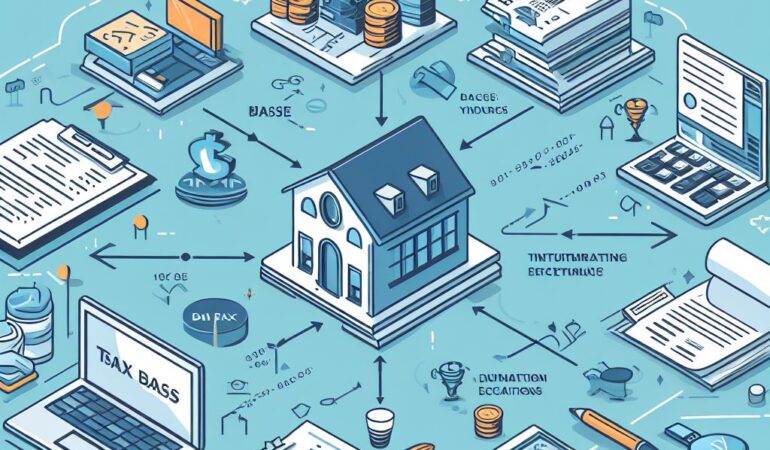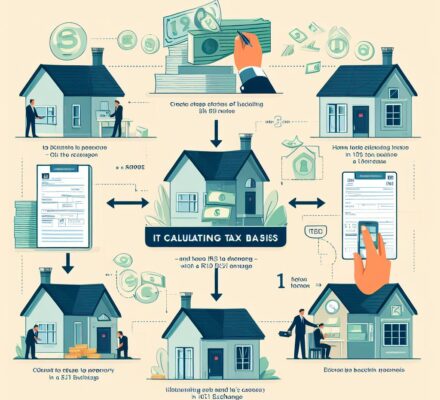Do you find yourself struggling to accurately determine tax basis in 1031 exchanges? Don’t worry, we’ve got you covered.
In this article, we will walk you through the simple steps to ensure you have a solid understanding of tax basis.
By gathering necessary documentation, calculating the original tax basis, and making adjustments as needed, you can confidently navigate the world of 1031 exchanges.
So, let’s get started on your journey to determining tax basis with ease.
Key Takeaways
- Tax basis is crucial for calculating gain or loss in a 1031 exchange and is generally equal to the original purchase price of the property.
- Adjustments may need to be made to the tax basis, such as adding the cost of improvements or subtracting depreciation deductions.
- Gathering necessary documentation, including purchase and sale agreements, closing statements, receipts for improvements, and depreciation records, is essential for accurately determining tax basis.
- Accurate record-keeping is crucial for future reference and helps track the cost basis, make accurate calculations, and maximize tax benefits while avoiding issues with the IRS.
Understand the Concept of Tax Basis
To fully comprehend the concept of tax basis in 1031 exchanges, you should frequently refer to the original purchase price of the property. The tax basis is the starting point for calculating gain or loss when exchanging properties under Section 1031 of the Internal Revenue Code. It’s crucial to understand how the tax basis is determined to accurately calculate any potential tax liability.
The tax basis is generally equal to the original purchase price of the property. However, several adjustments may need to be made to the tax basis depending on certain factors. For example, if you have made improvements to the property since its purchase, the cost of those improvements should be added to the tax basis. On the other hand, if you have claimed depreciation deductions on the property, those deductions should be subtracted from the tax basis.
Additionally, any expenses incurred during the exchange process, such as closing costs or fees, should also be factored into the tax basis. These adjustments ensure that the tax basis accurately reflects the true economic value of the property at the time of the exchange.
Gather Necessary Documentation
To accurately determine the tax basis in 1031 exchanges, you’ll need to gather the necessary documentation. This step is crucial in ensuring that your tax basis is accurately calculated and reported.
Here are the key documents you should gather:
- Purchase and sale agreements: These documents provide details about the acquisition and disposition of the properties involved in the exchange. They’re essential in determining the original cost basis and the selling price.
- Closing statements: These documents outline the financial transactions that occurred during the closing of the properties. They include information about the purchase price, closing costs, and any adjustments made.
- Receipts for improvements: If you made any improvements or renovations to the property, it’s important to have receipts for these expenses. These costs can be added to the tax basis to increase the basis and potentially reduce the taxable gain.
- Depreciation records: If the property has been depreciated, you’ll need to gather the depreciation records, including schedules and calculations. Depreciation reduces the tax basis over time, so it’s crucial to have accurate records for this deduction.
Calculate the Original Tax Basis
Start by calculating the original tax basis for your property. This is a crucial step in accurately determining your tax obligations in a 1031 exchange. The original tax basis represents the value of your property for tax purposes and serves as the starting point for calculating any gain or loss you may incur during the exchange.
To calculate the original tax basis, you’ll need to consider several factors. First, you should include the purchase price of the property. This includes not only the actual amount you paid for the property but also any additional costs incurred, such as legal fees or closing costs.
Next, you should factor in any improvements made to the property. This includes renovations, additions, or any other enhancements that have increased the property’s value. Be sure to include the cost of these improvements in your calculations.
Additionally, you should account for any depreciation that has been taken on the property. Depreciation is the decrease in value of the property over time, and it can affect the original tax basis. Consult with a tax professional or refer to your tax records to determine the amount of depreciation to include.
Determine Adjustments and Improvements
Make sure you accurately determine adjustments and improvements to your property when calculating the tax basis for a 1031 exchange. This step is crucial in order to ensure that you properly account for any changes made to the property during your ownership.
Here are some key points to consider:
- Repairs and Maintenance: Identify any expenses incurred for repairs and maintenance that were necessary to keep the property in good condition. This includes fixing leaks, replacing broken windows, or repainting the interior.
- Renovations and Upgrades: Take into account any substantial improvements made to the property that enhance its value or extend its useful life. This could include adding a new roof, installing energy-efficient windows, or renovating the kitchen.
- Capital Improvements: Determine any major capital improvements that were made to the property, such as adding a swimming pool or expanding the square footage. These improvements typically increase the property’s overall value.
- Landscaping and Land Improvements: Consider any enhancements made to the landscaping or land itself, such as adding a patio, installing irrigation systems, or clearing land for additional parking.
By accurately determining these adjustments and improvements, you can ensure that your tax basis is calculated correctly for the 1031 exchange. This will help you maximize your tax benefits and avoid any potential issues with the IRS.
Once you have determined these adjustments and improvements, it’s important to keep accurate records for future reference.
Keep Accurate Records for Future Reference
Maintain meticulous documentation to ensure the accuracy and integrity of your records for future reference in a 1031 exchange. Keeping accurate records is crucial when it comes to determining the tax basis of your property. By maintaining detailed documentation of all relevant transactions and expenses, you can easily track the cost basis and make accurate calculations.
To help you understand the importance of accurate record-keeping, consider the following example:
| Date | Transaction Description |
|---|---|
| 01/01/2020 | Purchase Price |
| 02/15/2020 | Closing Costs |
| 03/01/2021 | Capital Improvements |
| 05/01/2022 | Depreciation |
In this hypothetical scenario, the purchase price and closing costs are recorded on the date of the transaction. Capital improvements, such as renovations or additions, are documented separately to determine the adjusted basis. Lastly, depreciation is tracked to accurately calculate the remaining basis of the property.
Frequently Asked Questions
Can Tax Basis Be Adjusted for Inflation or Changes in Property Value?
Yes, tax basis can be adjusted for inflation or changes in property value. This is important to accurately determine the tax consequences of a 1031 exchange.
How Do I Determine the Tax Basis for a Property That Has Been Inherited?
To determine the tax basis for an inherited property, start by finding the fair market value on the date of the decedent’s death. This becomes the new basis for calculating any future gains or losses.
Is There a Deadline for Gathering Necessary Documentation to Determine Tax Basis?
There is a deadline for gathering the necessary documentation to determine tax basis. Make sure to gather all the required information within the given timeframe to accurately determine your tax basis.
Can I Include Expenses From Prior Years When Calculating the Original Tax Basis?
No, you cannot include expenses from prior years when calculating the original tax basis. The tax basis is determined based on the purchase price of the property and any additional costs incurred at the time of acquisition.
What Happens if I Don’t Keep Accurate Records of Adjustments and Improvements Made to the Property?
If you don’t keep accurate records of adjustments and improvements made to the property, it can be challenging to determine the tax basis in 1031 exchanges. This may result in incorrect reporting and potential tax consequences.




